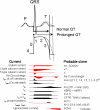Drug-induced long QT syndrome
- PMID: 21079043
- PMCID: PMC2993258
- DOI: 10.1124/pr.110.003723
Drug-induced long QT syndrome
Abstract
The drug-induced long QT syndrome is a distinct clinical entity that has evolved from an electrophysiologic curiosity to a centerpiece in drug regulation and development. This evolution reflects an increasing recognition that a rare adverse drug effect can profoundly upset the balance between benefit and risk that goes into the prescription of a drug by an individual practitioner as well as the approval of a new drug entity by a regulatory agency. This review will outline how defining the central mechanism, block of the cardiac delayed-rectifier potassium current I(Kr), has contributed to defining risk in patients and in populations. Models for studying risk, and understanding the way in which clinical risk factors modulate cardiac repolarization at the molecular level are discussed. Finally, the role of genetic variants in modulating risk is described.
Figures







Similar articles
-
Cellular basis of drug-induced torsades de pointes.Br J Pharmacol. 2008 Aug;154(7):1502-7. doi: 10.1038/bjp.2008.238. Epub 2008 Jun 16. Br J Pharmacol. 2008. PMID: 18552874 Free PMC article. Review.
-
Predicting drug-induced QT prolongation and torsades de pointes.J Physiol. 2016 May 1;594(9):2459-68. doi: 10.1113/JP270526. Epub 2016 Jan 18. J Physiol. 2016. PMID: 26660066 Free PMC article. Review.
-
Is gender a risk factor for adverse drug reactions? The example of drug-induced long QT syndrome.Drug Saf. 2001;24(8):575-85. doi: 10.2165/00002018-200124080-00002. Drug Saf. 2001. PMID: 11480490 Review.
-
Molecular predictors of drug-induced prolongation of the QT interval.Curr Med Chem Cardiovasc Hematol Agents. 2005 Apr;3(2):105-18. doi: 10.2174/1568016053544318. Curr Med Chem Cardiovasc Hematol Agents. 2005. PMID: 15853698 Review.
-
A new biomarker--index of cardiac electrophysiological balance (iCEB)--plays an important role in drug-induced cardiac arrhythmias: beyond QT-prolongation and Torsades de Pointes (TdPs).J Pharmacol Toxicol Methods. 2013 Sep-Oct;68(2):250-259. doi: 10.1016/j.vascn.2013.01.003. Epub 2013 Jan 19. J Pharmacol Toxicol Methods. 2013. PMID: 23337247
Cited by
-
Exploiting mathematical models to illuminate electrophysiological variability between individuals.J Physiol. 2012 Jun 1;590(11):2555-67. doi: 10.1113/jphysiol.2011.223313. Epub 2012 Apr 10. J Physiol. 2012. PMID: 22495591 Free PMC article. Review.
-
Two Sudden and Unexpected Deaths of Patients with Schizophrenia Associated with Intramuscular Injections of Antipsychotics and Practice Guidelines to Limit the Use of High Doses of Intramuscular Antipsychotics.Case Rep Psychiatry. 2016;2016:9406813. doi: 10.1155/2016/9406813. Epub 2016 Aug 15. Case Rep Psychiatry. 2016. PMID: 27597919 Free PMC article.
-
Inflammation as a Risk Factor in Cardiotoxicity: An Important Consideration for Screening During Drug Development.Front Pharmacol. 2021 Apr 19;12:598549. doi: 10.3389/fphar.2021.598549. eCollection 2021. Front Pharmacol. 2021. PMID: 33953668 Free PMC article.
-
A Possible Explanation for the Low Penetrance of Pathogenic KCNE1 Variants in Long QT Syndrome Type 5.Pharmaceuticals (Basel). 2022 Dec 13;15(12):1550. doi: 10.3390/ph15121550. Pharmaceuticals (Basel). 2022. PMID: 36559002 Free PMC article.
-
Rationalizing Secondary Pharmacology Screening Using Human Genetic and Pharmacological Evidence.Toxicol Sci. 2019 Feb 1;167(2):593-603. doi: 10.1093/toxsci/kfy265. Toxicol Sci. 2019. PMID: 30346593 Free PMC article.
References
-
- Abbott GW, Sesti F, Splawski I, Buck ME, Lehmann MH, Timothy KW, Keating MT, Goldstein SA. (1999) MiRP1 forms IKr potassium channels with HERG and is associated with cardiac arrhythmia. Cell 97:175–187 - PubMed
-
- Abrahamsson C, Palmer M, Ljung B, Duker G, Bäärnhielm C, Carlsson L, Danielsson B. (1994) Induction of rhythm abnormalities in the fetal rat heart. A tentative mechanism for the embryotoxic effect of the class III antiarrhythmic agent almokalant. Cardiovasc Res 28:337–344 - PubMed
-
- Aiba T, Shimizu W, Inagaki M, Noda T, Miyoshi S, Ding WG, Zankov DP, Toyoda F, Matsuura H, Horie M, et al. (2005) Cellular and ionic mechanism for drug-induced long QT syndrome and effectiveness of verapamil. J Am Coll Cardiol 45:300–307 - PubMed
-
- Albert CM, Nam EG, Rimm EB, Jin HW, Hajjar RJ, Hunter DJ, MacRae CA, Ellinor PT. (2008) Cardiac sodium channel gene variants and sudden cardiac death in women. Circulation 117:16–23 - PubMed
Publication types
MeSH terms
Substances
Grants and funding
LinkOut - more resources
Full Text Sources
Other Literature Sources
Medical

